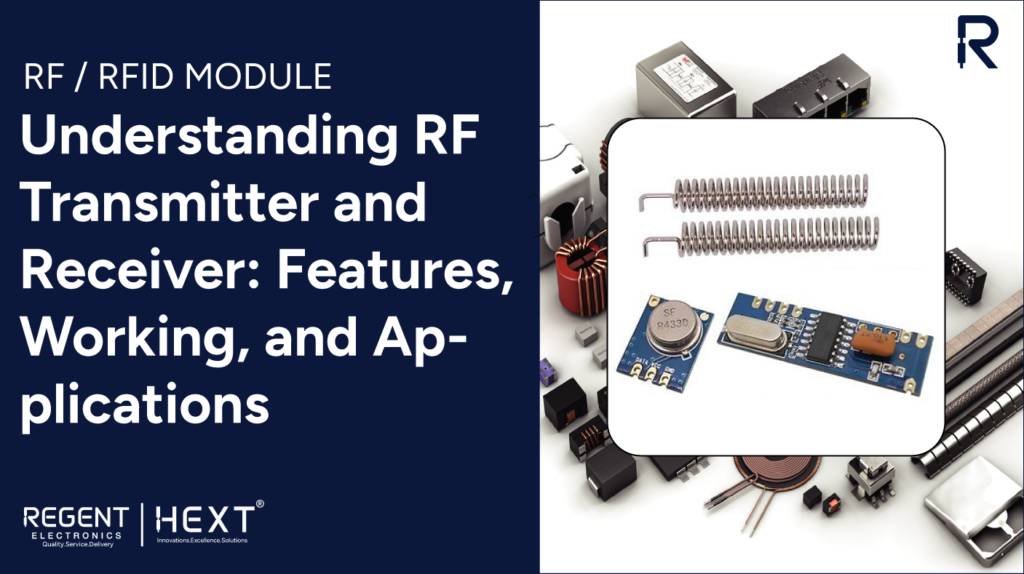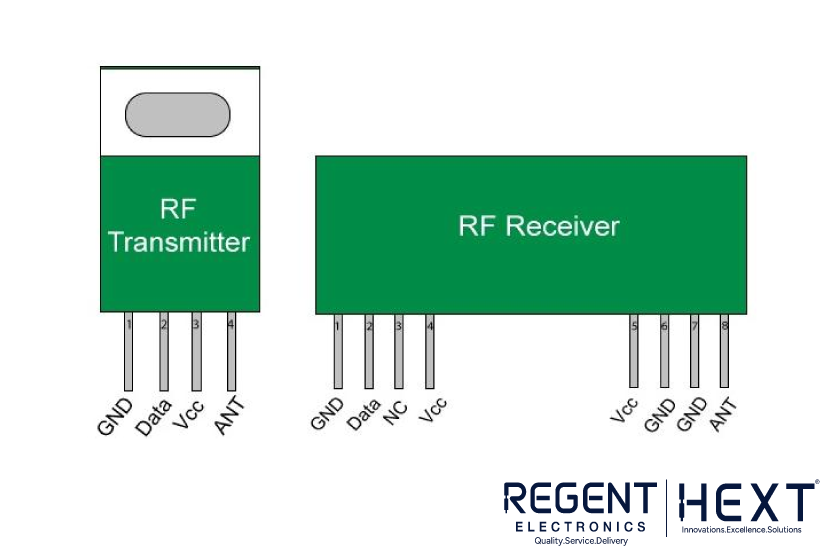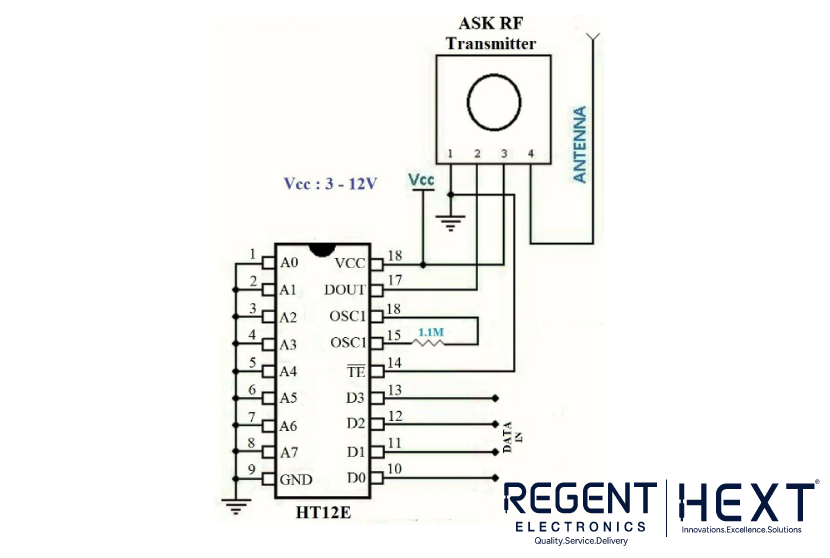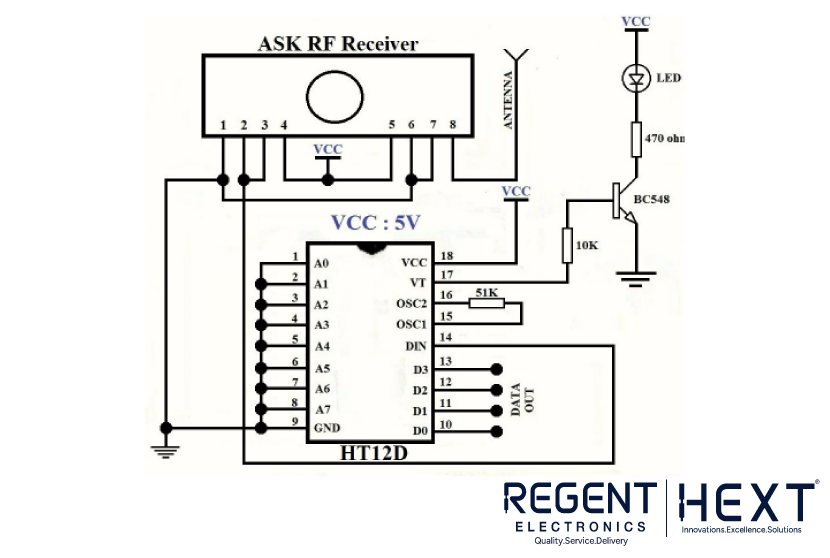
Understanding RF Transmitter and Receiver: Features, Working, and Applications
In the world of wireless communication, RF (Radio Frequency) modules play a crucial role. Whether it’s smart home systems, remote controls, or industrial automation—RF transmitters and receivers are everywhere. In this article by Regent Electronics, we’ll explain what RF transmitter and receiver modules are, how they work, their key features, and a wide range of real-world applications.
What is an RF Transmitter and Receiver?
Unlike infrared (IR) communication, which requires a direct line of sight, RF communication can transmit data over long distances without line-of-sight alignment. This makes it more versatile and reliable for outdoor and complex environments.
An RF module consists of two main components:
- RF Transmitter (Tx)
- RF Receiver (Rx)
Together, they form a communication system capable of sending and receiving digital data using radio waves. One of the most commonly used frequencies for these modules is 433 MHz, which offers a good balance between range and power efficiency.
What is an RF Module?

An RF module operates within the radio frequency spectrum, typically between 30 kHz and 300 GHz. It uses Amplitude Shift Keying (ASK) to encode digital data into analog radio signals for transmission. This method modulates the amplitude of the carrier wave to represent binary data.
Features of RF Transmitter and Receiver Module
Here are the key specifications of a standard 433 MHz RF module:
Receiver (Rx):
- Operating Frequency: 433 MHz
- Sensitivity: Up to -105 dBm
- Current Consumption: ~3.5 mA
- Operating Voltage: 5V
- Low Power Operation
Transmitter (Tx):
- Frequency Range: 433.92 MHz
- Supply Voltage: 3V – 6V
- Output Power: 4 dBm to 12 dBm
- Data Rate: 1 Kbps to 10 Kbps
How RF Modules Work

RF Transmitter
The RF transmitter consists of three main pins: Vcc, Data (Din), and Ground. It operates at a voltage range of 3V to 12V and transmits ASK-modulated signals at 433 MHz. The transmitter typically consumes 9mA to 40mA depending on transmission activity.
RF Receiver
The RF receiver includes four pins: Vcc, Dout, Linear Out, and Ground. It requires a regulated 5V supply and consumes less than 5.5mA during operation. It receives the ASK-modulated signal and demodulates it to recover the original data.
Circuit Diagram Overview

RF Transmitter Circuit
The HT12E encoder IC is commonly used with RF transmitters. It converts 4-bit parallel data into a serial signal, which is then transmitted wirelessly.
RF Receiver Circuit

On the receiving end, the HT12D decoder IC takes the incoming serial data and converts it back into 4-bit parallel format, activating the appropriate output pins.
Why Use Encoders and Decoders?
While RF modules can operate without encoding and decoding, they are extremely limited—only supporting a single input and output. To enable multiple input/output channels, encoder (HT12E) and decoder (HT12D) chips are used.
- HT12E/HT12D support 4 data bits and 8 address bits.
- With 4 data bits, you can create 16 unique combinations.
- Both encoder and decoder must be set to the same address configuration for proper communication.
Applications of RF Modules
RF modules are widely used across numerous industries and hobbyist projects due to their reliability and affordability. Common applications include:
- Remote control systems for appliances and robotics
- Wireless home security systems
- Smart lighting and home automation
- Vehicle tracking and monitoring
- Industrial telemetry and data acquisition
- Wireless meter reading
- Access control systems
- Wireless alarms and fire protection systems
- Digital audio/video transmission
- Biological signal monitoring
- Hydrological and weather stations
- Wireless data terminals and sensors
- Smart agriculture solutions
- Contactless RF cards and ID systems
- Mobile web-based healthcare monitoring
- Remote-controlled toys and drones
Final Thoughts
We hope this guide has helped you understand the fundamentals of RF transmitter and receiver modules. These devices are a powerful tool in the field of wireless communication, with applications ranging from hobby electronics to critical industrial systems.
At Regent Electronics, we’re passionate about helping makers, engineers, and innovators explore the exciting possibilities of RF communication. Stay tuned for more tutorials, insights, and product recommendations from our experts!
